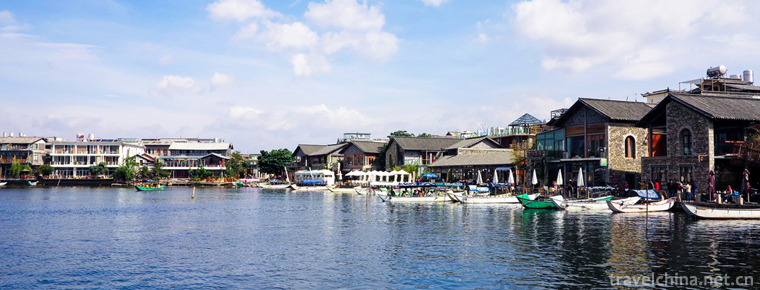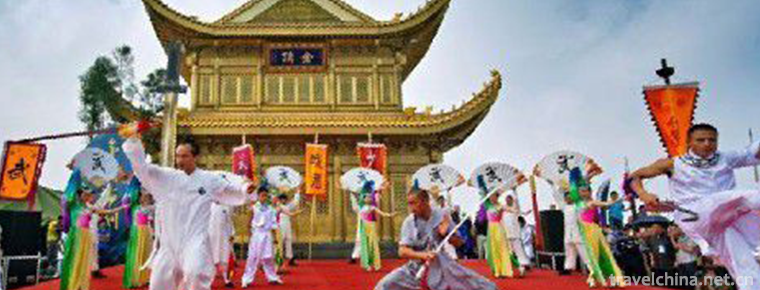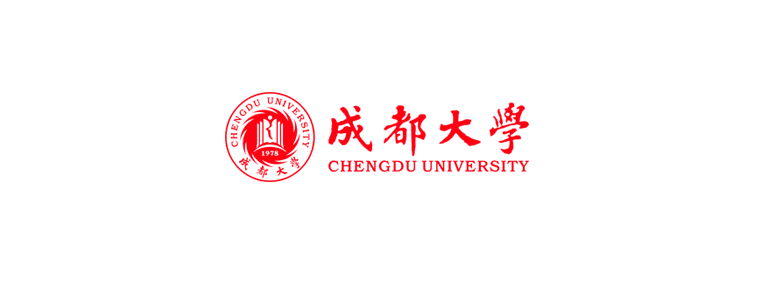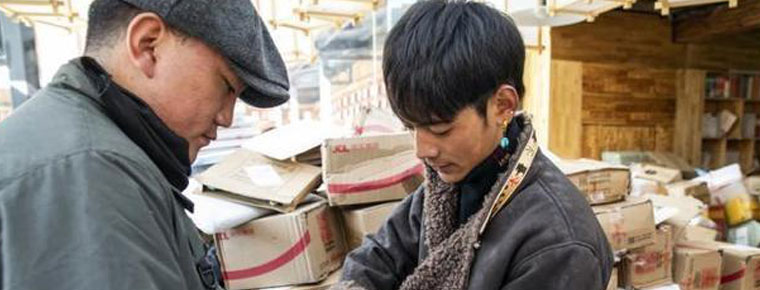Famen Temple Buddhist Cultural Scenic Area
Famen Temple Cultural Scenic Area is located in Famen Town, 10 kilometers north of Fufeng County, Baoji City, Shaanxi Province. It is 110 kilometers east of Xi'an City and 90 kilometers west of Baoji City. Founded in the reign of Hengling in the late Eastern Han Dynasty, it has a history of more than 1700 years. It is known as the ancestor of Guanzhong Pagoda Temple. It has become a sacred place of Buddhism that the whole country looks up to because of the placement of Sakyamuni Buddha's finger bones. On May 9, 2009, Famen Temple Cultural Scenic Area was built and opened to the outside world.
Famen Temple Cultural Scenic Area covers an area of 1300 mu. It consists of Shanmen Square, Foguang Avenue, Famen Temple, Heshi Shrine Tower and many sculptures.
On October 11, 2014, the Famen Temple Buddhist Cultural Scenic Spot in Baoji City was awarded the title of National 5A Tourist Scenic Spot after being strictly evaluated by the Quality Grading Committee of Chinese Tourist Scenic Spots.
The 27th World Fellowship of Buddhists was held at Famen Temple in Baoji, China, from October 16 to 19, 2014. This is the first time that the "World Buddhist Federation" conference has been held in the Mainland of China.
Historical development
Initial establishment
Famen Temple was built in the last years of the Eastern Han Dynasty in Hengling. Famen Temple built a pagoda for the sake of Sari. The wooden pagoda has four floors. There is a underground palace under the pagoda. The coffin made of rosewood is stored in the underground palace. The Buddha's finger bones are stored in a golden vase. The wooden pagoda is called "True Shri Pagoda". It was built because of the pagoda, formerly known as Ashoka Temple. After the extinction of Sakyamuni Buddha, the body was cremated into a relic. In the third century B.C., King Asoka unified India and divided the Buddha's relics into 84,000 copies in order to carry forward the Buddha's Dharma, so that the ghosts and gods could be distributed to all countries in the world to build pagodas for worship. There are 19 places in China, and Famen Temple is the fifth place.
The wooden pagoda dedicated to Buddha's bones and relics in Famen Temple was destroyed repeatedly during the war-torn sixteen countries and the melee between the Northern and Southern Dynasties. In particular, Emperor Taiwu Tuoba adopted Cui Hao's suggestion to ban Buddhism and destroy Buddhist scriptures, statues and pagodas, which resulted in the ruins of the pagoda. But at that time, there were still believers who came to burn incense and worship Buddha. This place was called "Holy Tomb" by people at that time. In 558 AD, the descendants of the royal family of the Northern Wei Dynasty, Qizhou Mutuobayu restored the Ashokang Temple and the Shrita. In the second year of the Yuan and Wei Dynasties (555), Emperor Gong of the Western Wei Dynasty opened the pagoda for the first time to celebrate the sacrifices. Famen Temple became one of the four major Buddhist resorts in China.
Sui Wendi Kaihuang three years (583) was renamed "Chengshi Daochang", and the Shrita was also called "Chengshi Daochang Lita". In the second year of Renshou (602), Li Min opened the pagoda for the second time. In the second year of Yining in Sui Dynasty (618), it changed "Chengshi Daochang" to "Famen Temple", which is also called "Famen Temple Shrine Tower". It was a year when Famen Temple was burned by fire. After a flash of fire, only the remnants of the tower were left.
In the fifth year of Emperor Taizong's Zhenguan (632), Zhang Deliang of Qizhou Cishi built the Wangyun Hall on the base of the tower, replacing the tower with the hall, which has four floors. Tang Gaozong Xianqing five years (660) welcomed Buddha bones in Luoyang, East Capital. After three years of support, he was sent back to the underground palace of Famen Temple in the second year of Longshuo (662), and ordered monks Huigong and Yifang to rebuild the Famen Temple Pagoda. Tang Gaozong once donated 5,000 yuan of money and 5,000 pieces of silk to the monastery. Royal ministers also donated money in succession. The Fayuan Pearl Forest recorded its grand occasion, saying, "At that time, Taoism and customs inside and outside the capital were linked to each other by two hundred miles, and exchanges continued." Zhang Zu's "Ming of the True Body Pagoda of Wuyou Wang Temple" once described the renovated Famen Temple Pagoda as "pulling up a pillar to carry the sky". It is known that the Ashokang Temple is also known as "Wuyou Wang Temple", and the pagoda is also known as "Wuyou Wang Temple's True Body Pagoda". In the four years of Jinglong (710), the middle Tang Dynasty emperor inscribed the Shri Pagoda as the "Great Sage and True Body Pagoda", also known as the "Protecting the Nation and True Body Pagoda".
In the second year of Emperor Longde at the end of Hou Liang Dynasty (922), Li Maozhen, the former envoy of the Tang Dynasty, repaired the wooden pagoda, added diaphragm pillars at the center of the pagoda, and covered the top with green glazed tiles. After Li Maozhen's construction, the four-storey wooden pagoda was maintained until the late Ming Dynasty.
Sacrifice in the Tang Dynasty
During the more than 200 years of the Tang Dynasty, eight emperors, Gaozong, Wuhou, Zhongzong, Suzong, Dezong, Xianzong, Yizong and Qizong, successively offered Buddhist finger relics in June and February. Every greeting has a great momentum, a sensation in the court and the countryside, and the emperor worships with high rank. According to the historical records, "30 years open, then the rich and prosperous people", can calm down, Cathay, peace, good weather. On January 4, 874, the fifteenth year of Xiantong, Li Yan of Tang Qizong returned the bones of Buddha for the last time. According to Buddhist rituals, the Buddha finger relics and thousands of rare treasures were sealed into the underground palace under the tower and fed with Tang Mi Mandala altar. The emperors of the Tang Dynasty believed in Buddhism and offered sacred religion. The temples were magnificent and integrated, making Famen Temple a royal monastery and a sacred place of Buddhism that the whole world looked up to. The Buddha Pagoda is known as the Pagoda of Protecting the Nation and the True Body.
Welcome Buddha bones to the climax in the late Tang Dynasty. The so-called invitation to Buddha bones means that every 30 years, the Buddha bones stored in the underground palace under the tower are greeted to the Chang'an City Palace to look up. The greatest is Tang Yizong Xiantong 14 years (873). The invitation to Buddha bones was prepared in advance for two years. During the two hundred miles from Chang'an to Famen Temple, the chariots and horses kept running day and night, and there was food supply along the way, called "no hindrance to sandalwood". The chariots and horses for Buddha bones were guided by the Royal imperial forest army with clear armour and complete knives, guarded by ministers of civil and military affairs, supported by famous monks and monks, covered by flags, filled with drums and music, and worshiped with piety along the way. Good men and women. The streets of Chang'an city are tied with silk and satin to various colour buildings. Emperor Yizong also personally visited the Fortune Gate Tower to greet the top ceremony, while hundreds of officers and officials greeted along the street. The Buddha bones are first offered in the palace for three days, and then in turn at the temples in Beijing. Hundreds of civil and military officials and the great wealth of the rich race are fighting for gold and silk. People from all quarters help the old and bring the young to pay their respects and even cut off their arms to show their devotion. Since the invitation of Buddha bones, the underground palace has been closed and isolated for 1113 years. Famen Temple also suffered bad luck in the Tang Dynasty. Tang Wuzong destroyed Buddha on a large scale in Huichang five years (845), which was historically called "Huichang Fa is difficult". Tang Wuzong had ordered the destruction of Buddha's phalanx and finger bones, but before that, monks prepared several shadow bones (imitations) of Buddha's phalanx and finger bones for the purpose of eliminating monarch's life and hiding the real phalanx of Sakyamuni Buddha.
The Imperial Academy of Song Dynasty
Famen Monastery in Song Dynasty inherited the magnificent momentum of the Royal monastery in Tang Dynasty and was restored to the largest scale. At that time, only one of the 24 courtyards, the "bathroom yard" could bathe thousands of people in the sun. Huizong of Song Dynasty wrote the four words "Emperor Buddhist Kingdom" on the mountain gate. During the Jin and Yuan Dynasties, Famen Temple was still a famous temple in Guanzhong, and there were 5,000 volumes of records of Buddhist scriptures copied by monks in the tablets of Tibetan scriptures. The Jin Dynasty also inscribed "Poetry Stele" to praise its temple tower: "Three-tier eaves oppress Ludi, Nine Wheels strengthen Qinchuan".
Decline in Ming and Qing Dynasties
After Ming and Qing Dynasties, Famen Temple gradually declined. In the third year of Longqing Ming Dynasty (1569), an earthquake occurred in Fengxiang Prefecture. After hundreds of years of history, the four-magnitude wooden pagoda collapsed in the Tang Dynasty. Ming Shenzong Wanli seven years (1579), local gentry Yang Yuchen, party Wanliang and other donated funds to repair the tower, which lasted 30 years to build eight-edged and thirteen-level brick tower, 47 meters high, with carved brick edges, hanging bells at arch corners. The first floor of the pagoda is facing the south. There are exquisite stone carvings on the four facades of east, south, West and north. They are "Futuyaoyi", "Zhenzhen Pagoda", "Sheli Feixia", "Meiyang Town". The runes of Qian, Kan, Liang, Zhenzhen, Sung, Li, Kun and Bagua are embedded on the four sides of northeast, northwest, southwest and Southeast respectively. From the second to the eighth floors of the tower, there are bucket arches and railings. From the ninth floor, the eaves are pulled with green bricks. From the second to the twelfth floors of the tower, there are eight Buddhist shrines on each floor. Each shrine is dedicated to one to three bronze Buddhas, beside which there are letterboxes and iron nets. The top of the tower is cast in bronze, three pieces of which are connected into a gourd shape, and eight regular characters of "Made in the Thirty-seventh Year of Ming Wanli" are cast on it. Looking at the whole picture of the Shri Pagoda, the side of the pagoda is 27 meters long and 1.8 meters high. The Temple Pagoda is 60.25 meters tall, towering and magnificent after the addition of the pagoda, body and top. Craftsmen repairing Famen Temple in Longqing period of Ming Dynasty witnessed treasure boxes filled with Buddha bones in the underground palace. According to the Record of Fufeng County, the tower collapsed in Longqing, Ming Dynasty. Open its Tibetan view, Shen Shuzhang, fine workmanship, brilliant. Mercury is a pool on a Pan-Gold ship. The inner casket stores Buddha bones, while the golden robes are still in existence. However, in surprise, the craftsmen, out of respect for the Buddha, did not dare to disturb the boxes of Buddha bones and the treasures of the palace. The palace was then closed and a new pagoda was built on top of the palace.
In the eleventh year of Shunzhi in Qing Dynasty (1654), an earthquake occurred again in Guanzhong area. The pagoda of Famen Temple tilted southwest, and many Buddha statues fell to the ground from the niches. In the first year of Tongzhi in the Qing Dynasty (1862), the Famen Temple was once captured by unrest and destroyed by fire.
Repair in Republic of China
In the twenty-eighth year of the Republic of China (1939), under the chairmanship of Zhu Ziqiao, a patriot and then president of the North China Charity Association, Shanghai businessman Li Zushen and Li Zucai brothers donated 30,000 yuan and raised 20,000 yuan from all sides to complete the largest maintenance since the late Ming Dynasty, which lasted one year and four months and was completed in July 1940. When repairing Famen Temple, a craftsman once happened to find a corner of the underground palace. At that time, when China was facing domestic and foreign troubles, the war was raging. Japanese invaders bombed Xi'an and approached its surroundings. There were displaced victims everywhere. Moreover, the case of burglary of the Qingdong Tomb, which shocked the world, had just happened for 10 years. In order to ensure the safety of the underground palace, Mr. Zhu Ziqiao, who presided over the renovation of Famen Temple, immediately summoned the insiders and demanded that the secret be kept under oath and never let outsiders, especially the greedy Japanese, know it, otherwise he would be the perpetual sinner of the Chinese nation. Afterwards, it was proved that these insiders were indeed the most heavenly Qinchuan men, who promised a lot of money, and no one really disclosed the secret of the underground palace. Zhu Ziqiao and others re-closed the entrance to the underground palace and lied to the outside that the poisonous snakes were coiled in the cave under the tower and could not enter at all.
After the founding of PRC
During the Cultural Revolution, the Red Guards wanted to dig a tower, and Master Liangqing set fire to himself, protecting the treasures under the tower with his own life.
In August 1976, a great earthquake occurred in Songpan, Sichuan Province. The earthquake wave spread to Fufeng. The second layer of brick masonry on the southwestern side of Famen Temple Tower smashed and fell, and the tower body collapsed seriously to the southwest. After that, cracks and collapses occurred successively. By September 1981, the top of the tower had fallen by itself, leaving only half of the tower standing alone on the broken brick and stone platform.
In February 1987, when the brick pagoda of Famen Temple collapsed due to disrepair was constructed by the third-level cultural relics units of Fufeng County, Baoji City, Shaanxi Province, the underground palace of the Tang Dynasty was found, and the cultural treasures of the Tang Dynasty, which were sleeping in the ground in 1113, were discovered. A large number of precious cultural relics of the Tang Dynasty, including Buddha Sakyamuni's real finger bones and offering sacrifices, were also available. This is a major new discovery of Chinese archaeology after the Banpo and Qin terracotta warriors and horses.
The tower rebuilt in 1988 was built entirely in accordance with the octagonal style of the thirteenth generation of the Ming Dynasty, and the brick tower was changed into reinforced concrete structure.
On May 25, 2006, Famensi Site was approved by the State Council as an ancient site from the Northern and Southern Dynasties to the Qing Dynasty and listed in the Sixth Batch of national key cultural relics protection units. On October 1 of the same year, Shaanxi Famen Temple Cultural Scenic Spot Construction Co., Ltd. was approved to be established, and a management and construction team was dispatched from Qujiang New Area of Xi'an to take overall responsibility for the construction of Famen Temple Cultural Scenic Spot. The Summary of the Leading Group Meeting on Coordination of Development and Construction of Famen Temple Cultural Scenic Spot on the morning of October 16 of the same year put forward that the land requisition and demolition work should be coordinated by the Shaanxi Provincial Department of Land and Resources.
On April 16, 2007, Shaanxi Famen Temple Cultural Scenic Area Construction Co., Ltd., the main body of scenic area development and construction, was established. The registered capital of the company is 700 million yuan.
On May 9, 2009, Famen Temple Cultural Scenic Area was built and opened to the outside world.
Main attractions
Mountain Gate Plaza
The area of Shanmen Square is about 150,000 square meters. It consists of four parts: Buddha Guangmen, Prajna Gate, Bodhi Gate and Yuanrong Gate. This area covers hotels, vegetarian restaurants, Tang Zen tea, lecture halls, tourist shopping, tourist centers, supermarkets, battery car rental and other supporting implementations. The architectural design style of Shanmen Square is magnificent, and it is connected with Buddha's Light Avenue in the north. It implies the process of all living beings crossing from the shore world to the other shore world of Buddha.
Buddha Road
Foguang Avenue is 1230 meters long and 108 meters wide. 1 represents the only Sakyamuni phalanx relic in the world, 2 represents the old and new pagodas, 3 represents the design and planning of the three treasures of Buddhist monks, and 0 represents all living beings in all things. And 108, for example, the master holds 108 Rosary beads, each dial a Buddha bead represents to see through and put down a worry.
Foguang Avenue is divided into main road and auxiliary road. Ten Bodhisattvas and scriptures are displayed on the main road. The yellow pillars on both sides are Buddhist sacred objects. Buddhist sutras can often be used on them, which symbolizes that the wisdom of Buddhism can surrender all troubles. The Sutra Buildings are also arranged according to the five periods of Buddhism, namely Huayan Shi, Ahanshi, Fang et al., Prajna Shi and Fahua Shi. Huayan refers to the Dharma of the Dharma realm crossing the Great Bodhisattva, which emphasizes the Mahayana Buddha in this period. There are eight groups of landscape sketches in the east, West and auxiliary road. To the East is the Buddha's monument, and to the west is the source of the Dharma.
Famen Temple
Famen Monastery is located on the east side of the north section of Foguang Avenue. The total area of the monastery is about 30,000 square meters. Founded in the late Eastern Han Dynasty in the reign of Hengling, about 1700 years ago, it is known as the ancestor of Guanzhong Pagoda Temple. Famen Temple is built because of the pagoda built by the pagoda, formerly known as Asoka Monastery. Emperor Wendi of Sui Dynasty was renamed "Chengshi Daochang", and Li Yuanwude of Tang Dynasty was built and renamed "Famen Temple" in the seventh year (625), which is known as the Royal temple. Half of the pagoda collapsed on August 24, 1981. In 1986, the government decided to rebuild the pagoda, and at the end of February, 87, the pagoda was rebuilt. More than 2499 pieces of Tang Guobao heavy artifacts, surrounded by Buddha's real body finger bones and relics, returned to the world! The rare treasures unearthed in the underground palace are of great value in the study of Chinese social and political history, cultural history, history of science and technology, history of exchanges between China and foreign countries, and history of fine arts.
Shrita Square
On the north side of Foguang Avenue is the Six Degree Bridge, which is a necessary bridge for cultivating oneself into Buddha. "Du", Sanskrit is "Pramit polomedo", the word meaning is "to the other side", that is, from this side of trouble to the other side of consciousness. The so-called Six Degrees are six ways from worry to awakening and from here to the other, that is, the way of human practice. Six degrees are charity, admonition, humiliation, refinement, meditation, and Prajna (wisdom). Each time, the mind is washed once. The Six-degree Bridge is the only way for all living beings to go to the other shore through the Buddha's Light Avenue from the mountain gate and visit the Buddha's true body. Crossing the Six-Degree Bridge and the 100,000 square, we arrived in front of the Heshi Shrine Tower of Famen Monastery.
Namaste Dagoba
The Half Ten Shrine Tower, solemn and magnificent, worships the world's only Sakyamuni Phalangeal Shrine. The shape of the shrine pagoda is a combination of hands, which shows the ritual characteristics, basic concepts and the basic will of human beings to pursue peace. In the shape of hand-in-hand, the Tang Pagoda embodies the perfect integration of history and modern times. In the space of hand-in-hand, three Buddhas and Bodhisattvas are worshipped, which shows that this is the world of cosmic law. Through the architectural modelling of hand-in-hand, it shows the ideological connotation of harmony, harmony, harmony and peace in Buddhism.
Heshi Shrita is 148 meters high, and "one" means that Buddha is different from all living beings. Buddha is the awakened living beings, and all living beings are the unconscious Buddha. "Four" and "Eight" are the eighth day of April in the summer calendar. They are the birth of Buddha. They symbolize the ancient prosperity of harmony, well-being and national peace.
There are six floors of Heshi Shrita, which are divided into ground and palace parts. The underground palace covers an area of more than 5,000 square meters, more than 100 times larger than the mysterious underground palace of the ancient Famen Temple, and can accommodate more than 2,000 people. In the underground palace, there are four great heavenly kings, Maitreya Buddha and Wei Pu Bodhisattva in the south, and thousand-handed Guanyin and Tibetan Bodhisattva in the East and west. In the center of the underground palace, Sakyamuni Buddha is enshrined as an incarnation Buddha. On both sides of him, Ananda and Kaye are served. In front of the incarnation of Sakyamuni Buddha, there is a treasure letter of Sakyamuni Buddha, in which the Sakyamuni Buddha's real Sakyamuni is stored. Every major Buddhist festival, treasure letters are displayed for people to look up to sacred objects.
The second floor of the Heshi Shrita is dedicated to the Buddha of reincarnation. Walking up to 54 meters, you can see that the Buddha of Dharma is worshipped in the Tang Pagoda. From bottom to top, the Heshi Shrita worships Buddhism's three-body Buddha, implying "three-body statues, six-fold Dharma realm", which is the other side of people's ideal.
Standing 54 meters above the Heshi Shrine Tower, we can overlook the whole cultural scenic area. It is divided into three areas: Buddha, Buddha and monk. It integrates heaven, earth and human beings, and brings all living things together in the Famen.
Famen Temple Museum
Famen Temple Museum takes the most important archaeological discoveries of the Tang Dynasty's pagodas and underground palaces in China in the 20th century as its opportunity to build the museum. It takes the world's only real Buddha finger relics and rare cultural relics of the Tang Dynasty as its basis for collection, protection, research and exhibition. It is the first museum in China with the characteristics of the Tang palace treasures and Buddhist art. The number and grade of national treasure-grade cultural relics are based on the collection, protection, research and exhibition of the museum. The number of the above-mentioned relics accounted for the proportion of the cultural relics in the collection, which was the first in the domestic museums. It has become a unique tourist destination of Tang culture and Buddhist culture in Northwest China and an influential academic and cultural exchange center in China.
Famen Temple Underground Palace
Found in 1987, the Tang Dynasty underground palace of Famen Temple is the oldest, largest and highest-ranking pagoda underground palace in the world. A large number of cultural relics preserved in the underground palace are not only of high grade and variety, but also in good condition. It provides material evidence for the study of politics, economy, culture, religion and other disciplines in Tang Dynasty. It is of great significance to the history of Chinese culture and world culture. The underground palace relics of Famen Temple represent the top of the pyramid of Tang culture.
On April 3, 1987, 2 499 Tang Dynasty treasures were unearthed from the underground palace of Famen Temple, including 40 Chinese treasure-grade cultural relics, 148 first-class cultural relics, 25 second-class cultural relics and 62 third-class cultural relics.
Tourist guide
Tickets for scenic spots
Tickets are one-ticket system, 120 yuan in peak season (from March 1 to November 30) and 90 yuan in off season (from December 1 to February 29) each year. All scenic spots in Famen Temple, Famen Temple Museum and Heshi Shrita can be visited. All holders of student certificates can enjoy half-price discount .
Opening Hours
High season: 8:30-19:00 off season: 9:00-18:00
Traffic information
Baoji-Famen Temple Scenic Area Circuit
High speed:
1. Take the high-speed bus from Baoji Long-distance Bus Station to Fufeng Bus Station. It starts at 6:20 a.m. and ends at 18:40 a.m., every 15 minutes and 90 minutes. The fare is 22 yuan per ticket.
2. Transfer to Famensi Scenic Area at Fufeng Bus Station. The fare is 3 yuan and the journey is 10 minutes.
low speed
Take Baoji Long-distance Bus Station to Famen Monastery. The bus starts at 7:30 a.m. and ends at 16:30 a.m. once an hour. It takes 150 minutes to close the Central Line. The fare is 19 yuan per ticket.
Xi'an-Famen Temple Scenic Area Line: (The following lines are high-speed, 2 hours'journey)
1. Travel in the Tang Dynasty
Location of departure: West Gate of Furong Garden, Datang
Departure time: 8:00-11:00
Stop Location: East Parking lot of North Plaza of Dayan Pagoda
Return time: 14:30-16:00
2. Bus routes
You 2 (Xi'an Railway Station - Famen Temple) (3 flights per day)
Location of departure: East Square of Xi'an Railway Station
Departure time: 7:00-10:00
Return time: 13:00-16:00
3. Chengxi Passenger Station Line (Xi'an Chengxi Passenger Station-Famen Monastery)
Departure time:
Class 1: 8:45-9:00 a.m.
Class 2: 11:00-11:30 noon
Class 3: 16-16:20 p.m.
Famen Monastery-Xi'an City West Passenger Station
Departure time:
Class 1: 5:25 a.m.
Class 2: 13:00 p.m.











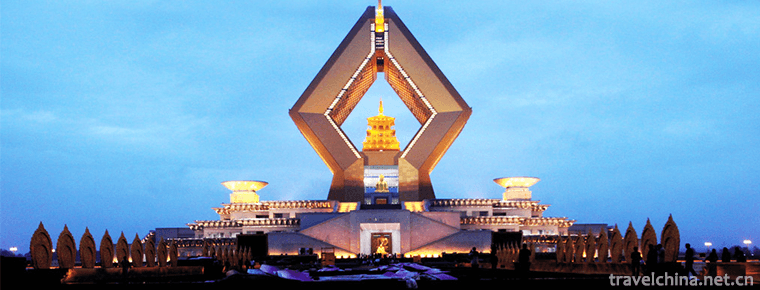
-
Shuanglang
located in the northeast of Dali City and the northeast coast of Erhai Lake.
Views: 243 Time 2018-10-17 -
Arctic Village Tourism Scenic Area
Arctic Village Tourist Scenic Spot: National AAAAA Class Tourist Spot, the most attractive scenic spot in 2014, and the northernmost scenic spot in China..
Views: 243 Time 2018-12-05 -
The First Bay Scenic Area of the Yangtze River
The first bay of the Yangtze River (the first bend of the Yangtze River and the first bay of the Wanli Yangtze River): located between Shigu Town of Lijiang City in the northwest of Yunnan Province an.
Views: 149 Time 2019-03-17 -
Beipiao Folk Stories
Beipiao Folklore is a local folk literature in Liaoning Province. It includes eight categories: folklore, character legend, fantasy story, life story, animal and plant story.
Views: 169 Time 2019-04-04 -
martial art of emei
Emei Wushu is one of the traditional Chinese Wushu schools, and its birthplace is Emei, a famous mountain in China. Including the worldwide spread of "Five Flowers".
Views: 108 Time 2019-04-28 -
hubei drum
The original name of Hubei drum is "drum book", also known as "drum storytelling" and "drum Beijing tune", etc. It is a traditional rap art popular in Xiaogan.
Views: 150 Time 2019-05-03 -
Cloisonne Production Techniques
Cloisonne production skills, Chongwen District, Beijing, local traditional skills, one of the national intangible cultural heritage..
Views: 119 Time 2019-05-08 -
Chengdu University
Chengdu University, established in 1978 with the approval of the Ministry of Education, is a comprehensive University jointly built by Sichuan Province and Chengdu City. It is a key comprehensive univ.
Views: 303 Time 2019-08-31 -
Shixiang Lake
Shixiang lake is named after Shixiang temple, an ancient temple in the lake area. It is said that it was the place where Yan Yan, a general of the Three Kingdoms, rode an elephant to heaven. .
Views: 199 Time 2020-10-16 -
Ding Zhen from the plateau Village
The 20-year-old Tibetan boy is from a small mountain village in Litang County, Ganzi Tibetan Autonomous Prefecture, Sichuan Province. More than 20 days ago, a photographer released a short video on the short video platform, which made Ding Zhen .
Views: 73 Time 2020-12-07 -
Overview of Guangyuan
In 2019, the GDP of Guangyuan will reach 94.185 billion yuan, an increase of 7.5% over the previous year, which is the same as that of the whole province. Among them, the added value of the primary industry was 15.301 billion yuan, an increase.
Views: 350 Time 2020-12-15
